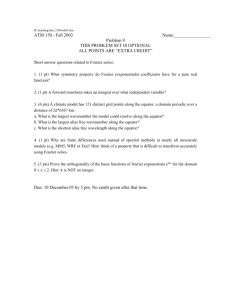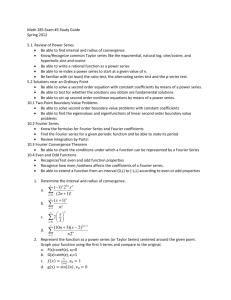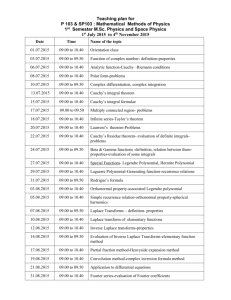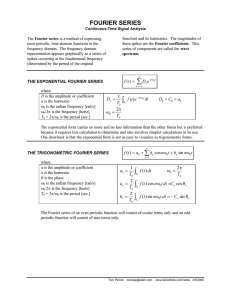Lecture VIII: Fourier series Maxim Raginsky September 19, 2008
advertisement
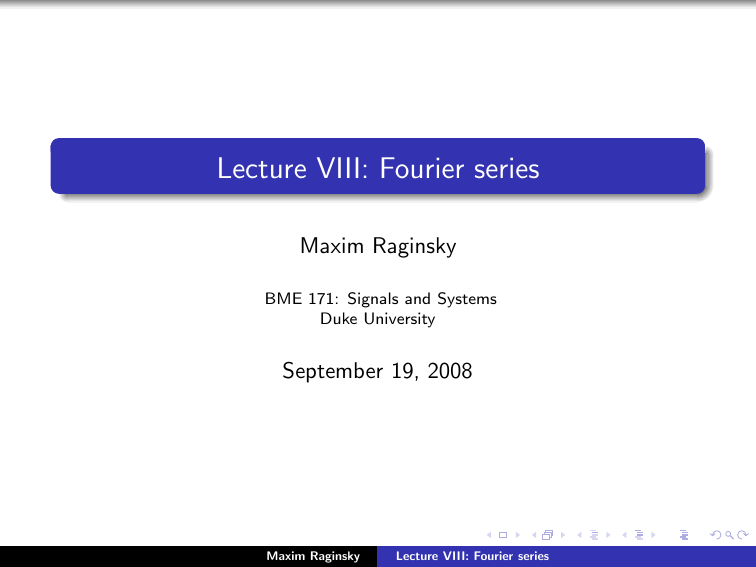
Lecture VIII: Fourier series
Maxim Raginsky
BME 171: Signals and Systems
Duke University
September 19, 2008
Maxim Raginsky
Lecture VIII: Fourier series
This lecture
Plan for the lecture:
1
Review of vectors and vector spaces
2
Vector space of continuous-time signals
3
Vector space of T -periodic signals
4
Complete orthonormal systems of functions
5
Trigonometric Fourier series
6
Complex exponential Fourier series
Maxim Raginsky
Lecture VIII: Fourier series
Review: vectors
Recall vectors in n-space Rn . Each such vector u can be uniquely
represented as a linear combination of n unit vectors e1 , . . . , en :
u = α1 e1 + α2 e2 + . . . + αn en ,
where α1 , . . . , αn are real numbers (coefficients). These can be
computed using the scalar (or dot) product as follows:
αk = u · ek ,
k = 1, . . . , n
Note that the vectors e1 , . . . , en are:
normalized — ek · ek = 1 for all k
orthogonal — ek · em = 0 for k 6= m
y
u
5
Example: u, v in R2
u = 3e1 + 5e2
v = 6.5e1 + 3e2
v
3
e2
0
e1
3
6.5
x
Maxim Raginsky
Lecture VIII: Fourier series
Vector spaces
By definition, vectors are objects that can be added together and
multiplied by scalars:
Pn
Pn
if u = k=1 αk ek and v = k=1 βk ek , then we can form their sum
u+v =
n
X
(αk + βk )ek
k=1
if u =
Pn
k=1
αk ek and β is a scalar, then we can form the vector
βu =
n
X
βαk ek
k=1
More generally, a collection of objects that can be added and/or
multiplied by scalars is called a vector space.
Maxim Raginsky
Lecture VIII: Fourier series
Signal spaces
We have already seen one example of a vector space — the space of
continuous-time signals. We can easily verify:
we can form the sum of any two signals x1 (t) and x2 (t) to get
another signal
x(t) = x1 (t) + x2 (t)
we can multiply any signal x(t) by a constant c to get another signal
z(t) = cx(t)
Unlike the n-space Rn , the vector space of all continuous-time signals is
huge. In fact, it is infinite-dimensional.
Maxim Raginsky
Lecture VIII: Fourier series
The space of periodic signals
Let us consider all T -periodic signals. Any such signal x(t) satisfies
x(t + T ) = x(t)
for all t
for some given T > 0.
It is easy to see that T -periodic signals form a vector space:
if x1 (t) and x2 (t) are T -periodic, then
x1 (t + T ) + x2 (t + T ) = x1 (t) + x2 (t),
so their sum is T -periodic
if x(t) is T -periodic, then
cx(t + T ) = cx(t),
so any scaled version of x(t) is also T -periodic
If we impose even more conditions on our T -periodic signals (the
so-called Dirichlet conditions, which hold for all signals encountered in
practice), then we can represent signals as infinite linear combinations of
orthogonal and normalized (orthonormal) vectors.
Maxim Raginsky
Lecture VIII: Fourier series
Complete orthonormal sets of functions
First of all, we can define a scalar (or dot) product of two T -periodic
signals x1 (t) and x2 (t) as
Z T
hx1 , x2 i =
x1 (t)x2 (t)dt
0
(note that we can integrate over any whole period, not necessarily from
t = 0 to t = T ).
Then we can take any sequence of T -periodic functions (signals)
φ0 (t), φ1 (t), φ2 (t), . . . that are
Z T
1 normalized: hφk , φk i =
φ2k (t)dt = 1
0
2
3
orthogonal: hφk , φm i =
Z
T
0
φk (t)φm (t)dt = 0 if k 6= m
complete: if a signal x(t) is such that
Z T
hx, φk i =
x(t)φk (t)dt = 0 for all k, then x(t) ≡ 0
0
Maxim Raginsky
Lecture VIII: Fourier series
Fourier series
Let {φk (t)}∞
k=1 be a complete, orthonormal set of functions. Then any
“well-behaved” T -periodic signal x(t) can be uniquely represented as an
infinite series
∞
X
x(t) =
αk φk (t).
k=0
This is called the Fourier series representation of x(t). The scalars
(numbers) αk are called the Fourier coefficients of x(t) (with respect to
{φk (t)}) and are computed as follows:
αk = hx, φk i =
Z
T
x(t)φk (t)dt
0
In analogy to vectors in n-space, you can think of αk as the projection
(or component) of x(t) in the direction of φk (t).
Maxim Raginsky
Lecture VIII: Fourier series
Fourier coefficients
To derive the formula for αk , write
x(t)φk (t) =
∞
X
αm φm (t)φk (t),
m=0
and integrate over one period:
Z
0
|
T
x(t)φk (t)dt
{z
}
=
Z
T
0
hx,φk i
=
∞
X
m=0
= αk ,
∞
X
!
αm φm (t)φk (t) dt
m=0
αm
Z
|0
T
φm (t)φk (t)dt
{z
}
hφm ,φk i
where in the last line we use the fact that {φk } form an orthonormal
system of functions.
Maxim Raginsky
Lecture VIII: Fourier series
Convergence of Fourier series
It can be proved that, because the functions {φk } form a complete
orthonormal system, the partial sums of the Fourier series
x(t) =
∞
X
αk φk (t)
k=0
converge to x(t) in the following sense:
lim
N →∞
Z
T
0
x(t) −
!2
N
X
αk φk (t)
N
X
αk φk (t)
k=1
dt = 0
So, we can use the partial sums
xN (t) =
k=1
to approximate x(t).
Maxim Raginsky
Lecture VIII: Fourier series
Trigonometric Fourier series
Fact: the sequence of T -periodic functions {φk (t)}∞
k=0 defined by
q
2
sin(kω0 t), if k ≥ 1 is odd
1
qT
and φk (t) =
φ0 (t) = √
2
T
if k > 1 is even
T cos(kω0 t),
is complete and orthonormal. Here,
ω0 =
2π
T
is called the fundamental frequency. Orthonormality is quite easy to
show, completeness — not so much.
Thus, any well-behaved T -periodic signal x(t) can be represented as an
infinite sum of sinusoids (plus a constant term α0 φ0 ):
x(t) =
∞
X
αk φk (t)
k=0
Maxim Raginsky
Lecture VIII: Fourier series
Trigonometric Fourier series
A more common way of writing down the trigonometric Fourier series of
x(t) is this:
x(t) = a0 +
∞
X
ak cos(kω0 t) +
k=1
∞
X
bk sin(kω0 t)
k=1
Then the Fourier coefficients can be computed as follows:
a0
ak
bk
=
=
=
1
T
2
T
2
T
Z
T
x(t)dt
0
Z
T
x(t) cos(kω0 t)dt
0
Z
T
x(t) sin(kω0 t)dt
0
Recall that ω0 = 2π/T .
Maxim Raginsky
Lecture VIII: Fourier series
Trigonometric Fourier series
To relate this to the orthonormal representation in terms of the φk , we
note that we can write
Z T
1
1
x(t)φ0 (t)dt = √ α0
a0 = √
T
T
r
r Z0 T
2
2
α2k
x(t)φ2k (t)dt =
ak =
T 0
T
r Z T
r
2
2
bk =
α2k−1
x(t)φ2k−1 (t)dt =
T 0
T
Thus, we have
∞
∞
X
X
x(t) = a0 +
ak cos(kω0 t) +
bk sin(kω0 t)
k=1
√
1
= √ αk · T φ0 (t) +
T
=
∞
X
r
2
T
k=1
∞
X
k=1
α2k ·
r
∞
X
T
φ2k (t) +
α2k−1 ·
2
k=1
αk φk (t)
k=1
Maxim Raginsky
Lecture VIII: Fourier series
r
!
T
φ2k−1 (t)
2
Symmetry properties
Things to watch out for when computing the Fourier coefficients:
if x(t) is an even function, i.e., x(t) = x(−t) for all t, then all its
sine Fourier coefficients are zero:
Z
2 T /2
x(t) sin(kω0 t)dt = 0
bk =
T −2/T
if x(t) is an odd function, i.e., x(t) = −x(−t), then all its cosine
Fourier coefficients are zero:
Z
2 T /2
x(t) cos(kω0 t)dt = 0,
ak =
T −2/T
and
a0 =
1
T
Maxim Raginsky
Z
T /2
x(t)dt = 0
−2/T
Lecture VIII: Fourier series
Trigonometric Fourier series: example
Consider a 2-periodic signal x(t) given by repeating the square wave:
1
bk
0.8
0.6
=
0
−1
0.4
0.2
=
0
−0.2
−0.4
−0.6
=
−0.8
−1
−1
Z
−0.8
−0.6
−0.4
−0.2
0
0.2
0.4
0.6
0.8
1
=
a0 = 0 and ak = 0 for all k
(the signal has odd
symmetry)
x(t) = −
=
∞
X
4 sin2 (kπ/2)
k=1
kπ
Maxim Raginsky
sin(kπt)dt −
Z
1
sin(kπt)dt
0
1
1
0
1
[cos(kπt)]−1 +
[cos(kπt)]0
kπ
kπ
1 cos(−kπ) − 1 + cos(kπ) − 1
kπ
1
(2 cos(kπ) − 2)
kπ
4 sin2 (kπ/2)
−
kπ
−
sin(kπt) = −
∞
X
4
sin(kπt)
kπ
k odd
Lecture VIII: Fourier series
Trigonometric Fourier series: example
Approximating x(t) by partial sums of its Fourier series:
N = 10
N = 15
1.5
1.5
1
1
0.5
0.5
0
0
−0.5
−0.5
−1
−1.5
−1
−1
−0.5
0
0.5
1
−1.5
−1
−0.5
N = 50
0.5
1
0.5
1
N = 150
1.5
1.5
1
1
0.5
0.5
0
0
−0.5
−0.5
−1
−1.5
−1
0
−1
−0.5
0
0.5
1
−1.5
−1
−0.5
0
Note the Gibbs phenomenon: the Fourier series (over/under)shoots the
actual value of x(t) at points of discontinuity. In signal processing, this
effect is also called ringing.
Maxim Raginsky
Lecture VIII: Fourier series
Complex exponential Fourier series
Another useful complete orthonormal set is furnished by the complex
exponentials:
1
φk (t) = √ ejkω0 t ,
T
k = . . . , −2, −1, 0, 1, 2, . . .
where ω0 = 2π/T , as before.
Note that these functions are complex-valued, and we need to redefine
the dot product as
hx1 , x2 i =
Z
T
x1 (t)x∗2 (t)dt,
0
where x∗1 (t) denotes the complex conjugate of x2 (t). Then it is
straightforward to show that
Z
1 T jkω0 t −jmω0 t
1, k = m
hφk , φm i =
e
e
dt =
0,
k 6= m
T 0
Maxim Raginsky
Lecture VIII: Fourier series
Complex exponential Fourier series
Thus, we can expand any T -periodic x(t) as
∞
X
x(t) =
ck ejkω0 t
k=−∞
The Fourier coefficients are given by
ck =
1
T
Z
T
x(t)e−jkω0 t dt
0
To derive this, multiply the series representation of x(t) on the right by
e−jkω0 t and integrate from 0 to T .
Maxim Raginsky
Lecture VIII: Fourier series
Symmetry properties for real signals
Consider a real-valued T -periodic signal x(t). Then
ck =
1
T
Z
T
x(t)e−jkω0 t dt
and c−k =
0
1
T
Z
T
x(t)ejkω0 t dt = c∗k
0
Write ck in polar form:
ck = Ak ejθk ,
Ak = |ck |, θk = ∠ck
Then
ck = c∗−k
⇒
Ak = A−k and ∠ck = −∠c−k
Thus, for real signals the amplitude spectrum Ak has even symmetry,
while the phase spectrum θk has odd symmetry.
Maxim Raginsky
Lecture VIII: Fourier series
Amplitude and phase spectra
We can use the amplitudes Ak and the phases θk to represent the
spectrum (or frequency content) of x(t) graphically as follows:
A(ω)
−3ω0−2ω0 −ω0
0 ω0 2ω0 3ω0 ω
θ(ω)
−3ω0−2ω0 −ω0
0 ω0 2ω0 3ω0 ω
Observe that the amplitude spectrum A(ω) has even symmetry, while
the phase spectrum θ(ω) has odd symmetry.
Maxim Raginsky
Lecture VIII: Fourier series


